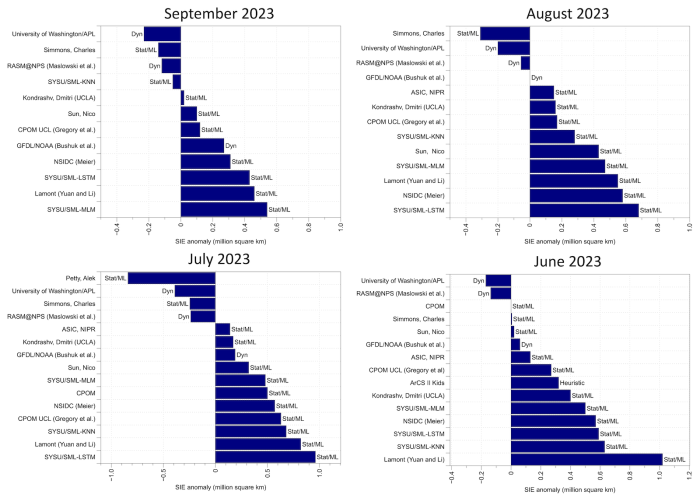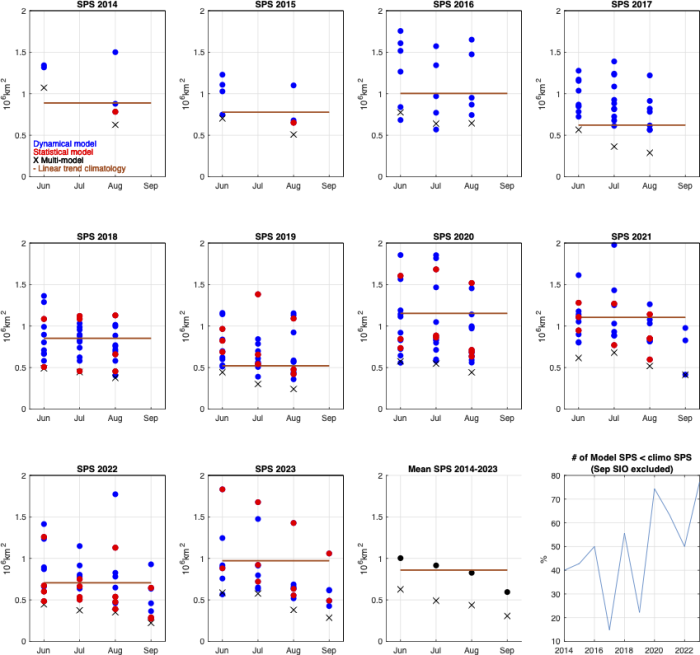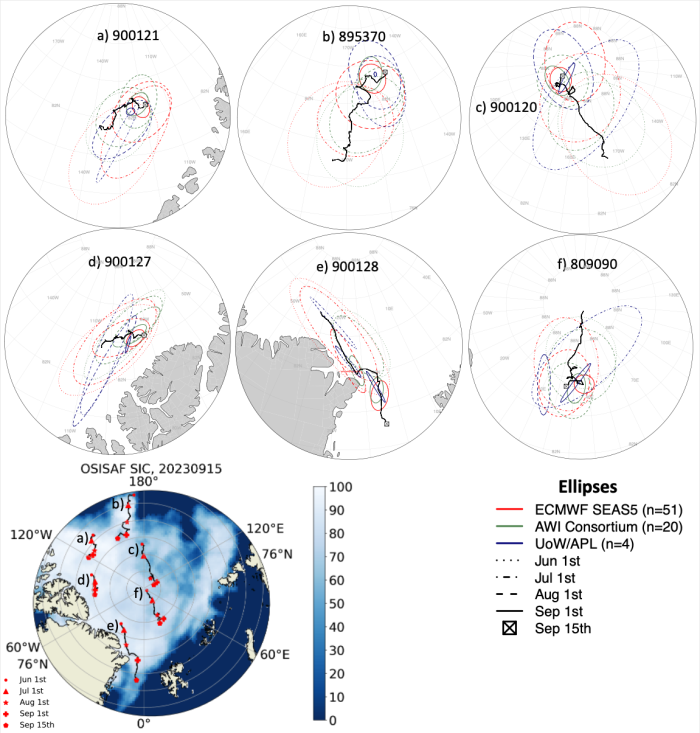Outlook Report
Executive Summary
The Sea Ice Outlook (SIO) is a community network activity led by the Sea Ice Prediction Network-Phase 2 (SIPN2) Project Team with contributions from key partners. SIPN2 is a community of scientists and stakeholders with the goal of advancing our understanding of the state and evolution of Arctic sea-ice cover. Support for the 2023 Outlook was provided by NSF award #1331083.
- The observed 2023 September monthly averaged sea-ice extent was 4.37 million square kilometers based on data from the National Snow and Ice Data Center (NSIDC) Sea Ice Index (SII).
- For the third year, the 2023 SIO included early September initialized forecasts and anomaly forecasts for September mean Arctic sea-ice extent. A total of 121 pan-Arctic September extent forecast submissions were received in June (40 submissions), July (30), August (29), and September (22) were received during the 2023 SIO season.
- The Arctic-wide Outlooks honed in on the observed extent after the July Outlook with median Outlooks values changing through the months: June (4.56 million square kilometers), July (4.66), August (4.60), September (4.50).
- For the Alaska Region (defined as the combined Bering, Chukchi, and Beaufort Seas), the SIO median forecast for June through September was 0.56, 0.56, 0.67, and 0.49 million square kilometers with a 2023 observed value of 0.20 million square kilometers. This was the second lowest value of the satellite record behind 2012 (0.12 million square kilometers).
- Spatial forecasts of September mean sea ice concentration showed a general improvement from June to September initializations, particularly for August and September, though some individual forecasts showed large errors. Over 75% of June through August forecasts beat the climatological forecast benchmark, the highest skill rate over 2014-2023.
- The Antarctic sea-ice extent reached 16.8 million square kilometers on average for September 2023, which is the lowest maximum observed in the record that begins in 1979. The Antarctic Outlooks did predict a low September extent, but the median Outlooks were well above the observed extent for each month, though some individual Outlooks in August and September did predict an extent as low or lower than the observed value.
- The SIO partner activity, Sea Ice Drift Forecast Experiment (SIDFEx), received forecasts for September buoy locations in the Arctic submitted by three 2023 SIO contributors. The hit rates are mostly in line with previous years, except for one buoy whose exceptionally fast drift was not captured by any of the forecast systems.
This 2023 Post-Season Sea Ice Outlook Report was developed by lead author Walt Meier, National Snow and Ice Data Center, CIRES, University of Colorado, Boulder (2023 Observed Arctic Conditions of pan-Arctic Sea Ice and Atmospheric Conditions); with contributions from Uma Bhatt, University of Alaska Fairbanks (UAF), Geophysical Institute (Executive Summary, 2023 Observed Arctic Conditions of pan-Arctic Sea Ice, Alaska Region Sea Ice, 2023 SIO Pan-Arctic Forecasts and Pan-Arctic Sea-ice Extent Anomalies, and Next Steps); Michael Steele, University of Washington (Discussion of Ocean Heat Conditions); François Massonnet, Université Catholique de Louvain (Review of 2023 Antarctic Contributions and Observed Antarctic Conditions); Ed Blanchard-Wrigglesworth, University of Washington (Discussion of 2023 pan-Arctic Spatial Forecasts); Helge Goessling and Valentin Ludwig, Alfred-Wegener Institute, SIDFEx Team (Discussion of SIDFEx results), Matthew Fisher, NSIDC (statistics and graphs); and Betsy Turner-Bogren and Helen Wiggins, ARCUS (report coordination and editing); and members of the SIPN2 Project Team.
2023 Observed Arctic Conditions
Sea Ice
Pan-Arctic Sea Ice
The September 2023 average Arctic sea-ice extent was 4.37 million square kilometers, which is fifth lowest in the satellite record (Figure 1). This was 2.04 million square kilometers below the 1981 to 2010 average and 0.8 million square kilometers above the lowest September average, in 2012. These values are based on the NSIDC Sea Ice Index (Fetterer et al., 2017) using the NASA Team algorithm passive microwave sea ice concentration products (DiGirolamo et al., 2022; Meier et al., 2021). There are several other sea ice concentration and extent products that have notable differences in extent (e.g., Meier and Stewart, 2019). However, trends and anomalies are more consistent between products (e.g., Comiso et al., 2017).
The September spatial distribution of ice concentration anomalies was zonally asymmetrical with much less ice in the Pacific sector of the Arctic while the ice edge in the Atlantic sector was closer to average, albeit still below average (Figure 2). While the Pacific sector was largely ice-free by September, ice retreat did start slowly in the spring and early summer, resulting in a relatively late opening of the Northern Sea Route, which also occurred in 2022.
Ice loss was slow compared to recent years during spring and early summer. The extent briefly was encompassed within the lower 1981—2010 inter-decile range during April and May. However, the rate of ice loss accelerated after mid-June. The loss rate continued to be fairly strong into September and the daily extent minimum date on September 19 was a week later than average. This led to the fifth lowest September extent in the record. The last 17 years (2007 through 2023) have had the 17 lowest September extents in the 45-year satellite record.

While the Northern Sea Route was slow to open, the Northwest Passage reached the second lowest level in the 55-year record (since 1967) of the Canadian Ice Service analyses, according to Steve Howell of Environment and Climate Change Canada (see: Arctic Sea Ice News & Analysis for more detail).
The September ice cover continued to be younger and thinner than earlier decades, based on Tschudi et al. (2019a,b). The extent of multiyear coverage decreased somewhat from September 2022 but remained near levels seen since 2006, i.e., about 50% below the multi-year extents in the 1980s and 1990s. The oldest ice (>4 years old) showed no rebound and has covered less than 300,000 square kilometers since 2012, compared to 1.5 to 2 million square kilometers in the 1980s and 1990s.
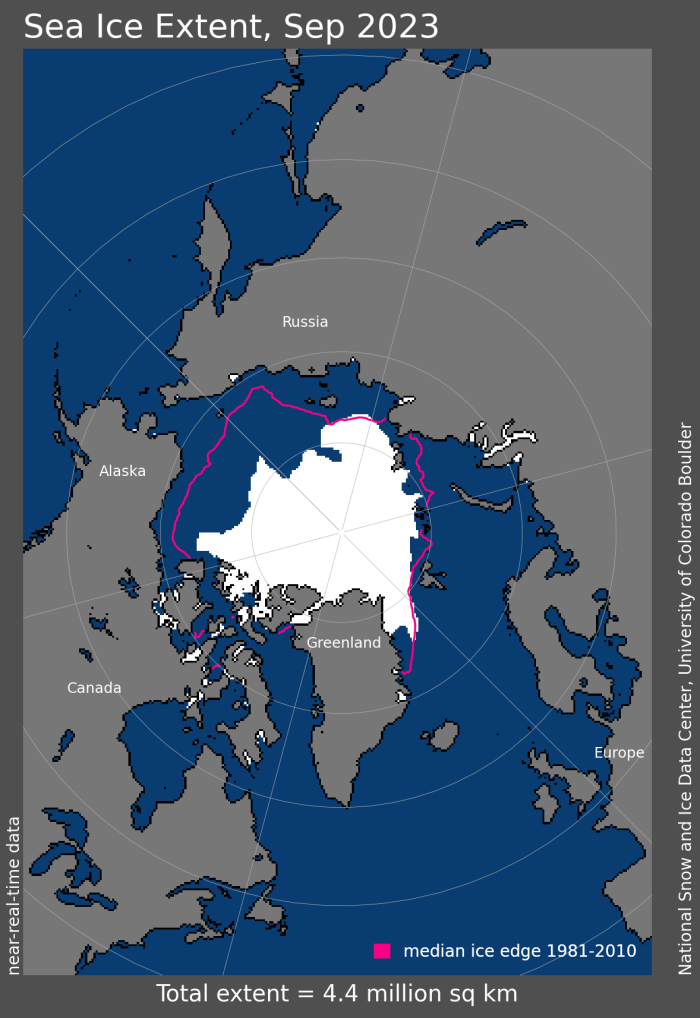
Alaska Region Sea Ice
The September mean sea-ice extent for the Alaska Seas was 0.20 million square kilometers, ranking second lowest over the satellite record (Figure 3). The September mean sea-ice extent in million square kilometers for the Bering Sea was 0.0013, Chukchi Sea was 0.031 (sixth lowest), and the Beaufort Sea was 0.17 (second lowest). The 2023 sea-ice extent in the Alaska seas was less than half the extent in September 2022 and the only year with a lower Alaska September extent was in 2012 (Figure 3). The seasonal cycle of daily sea-ice in the Alaska seas in 2023 was variable during winter and early spring, followed by an average decline through mid-July. After that, the extent dropped steeply through late-August, reaching the second lowest extent (Figure 4).
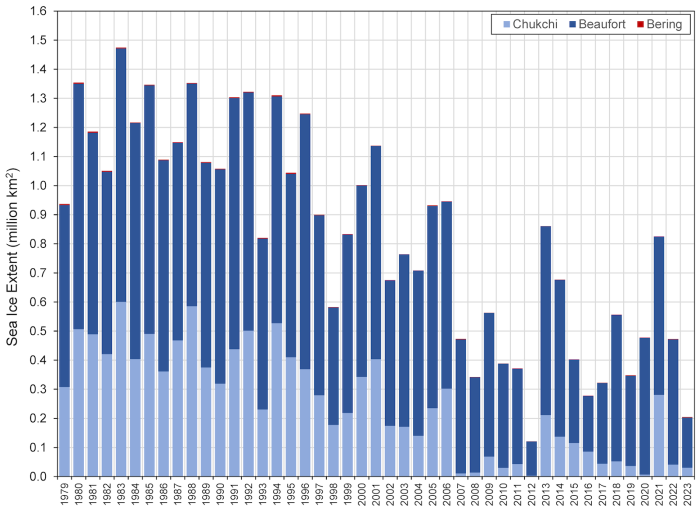

Atmospheric Conditions
During the 2023 summer (June through August), air temperatures at the 925 mb level were above average over the Arctic Ocean, but they were not as extreme as in many recent summers with temperatures largely ranging from 1 to 3 degrees Celsius above average (Figure 5). Only in parts of the Beaufort Sea did 2023 summer air temperatures reach up to 4 degrees Celsius above average. The main region of the Arctic Ocean with cooler conditions was in the central Arctic, north of the Laptev Sea where temperatures were ~1 degree Celsius below average.

Figure 5 is from the NOAA/ESRL website.
During June through August, average sea level pressure was low over much of the Siberian side of the Arctic, as well as over eastern Canada, and east of Greenland, with a small and weak Beaufort Sea High that primarily manifested itself in June (Figure 6). Summer-averaged pressure gradients were slack, particularly in July and August, albeit with intermittent stronger gradients caused by passing weather systems. Weak pressure gradients resulted in relatively weak surface winds and sea ice circulation through much of the summer.
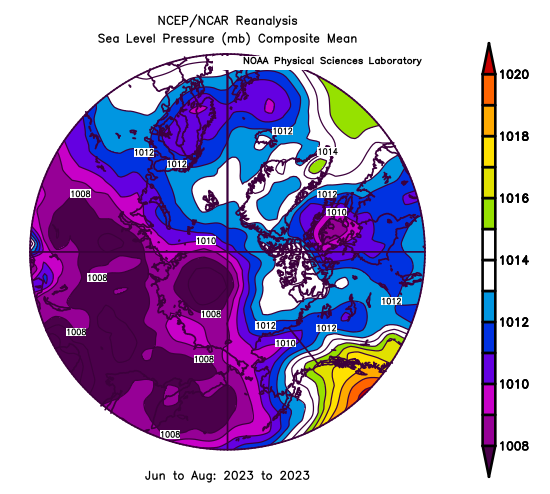
Figure 6 is from the NOAA/ESRL website.
Oceanic Heat
Overall, the end-of-summer sea surface temperature (SST) pattern in 2023 was quite similar to 2022 (Figure 7). However, in the Beaufort, Chukchi, and East Siberian Seas, ice retreat was earlier in 2023 relative to 2022, with resulting warmer SSTs and greater ice retreat. The East Siberian Sea is an interesting case, in that its ice retreat is generally late every year, but with variability that allows for some end-of-summer years with extensive ice cover (e.g., 2022) and others with completely open but quite cold SSTs (e.g., 2023).
The Laptev Sea is a site of early ice retreat and warm SSTs most summers, owing in part to thin ice created by southerly winds. In 2023, the typical pool of warm coastal waters formed by September, but unlike 2022, this warm open water did not anonymously extend toward the northeast. The factors that influence end-of-summer SSTs in this area include the timing of ice retreat, summer air temperature anomalies (see Figure 5) and possibly aerosol-laden advection from Siberia, and the cloud cover. The latter is becoming more important in recent years (Sledd et al., 2023).
The advection of warm Atlantic Water influences SSTs in the Barents and Kara Seas. In 2023, SSTs were a bit warmer than in the previous year (Figure 7), although not dramatically so. Atlantic Water enters this area in two streams: via the Barents Sea north of Norway and via eastern Fram Strait and then eastward along the northern edge of the Barents and Kara Seas. North of Svalbard, this warm water typically induces open water even in winter, a phenomenon sometimes called "Whaler's Bay." In 2022 and 2023, this warm water extended farther eastward than in most recent years, which may be an indicator of enhanced intrusion of Atlantic influence into the Arctic Ocean.
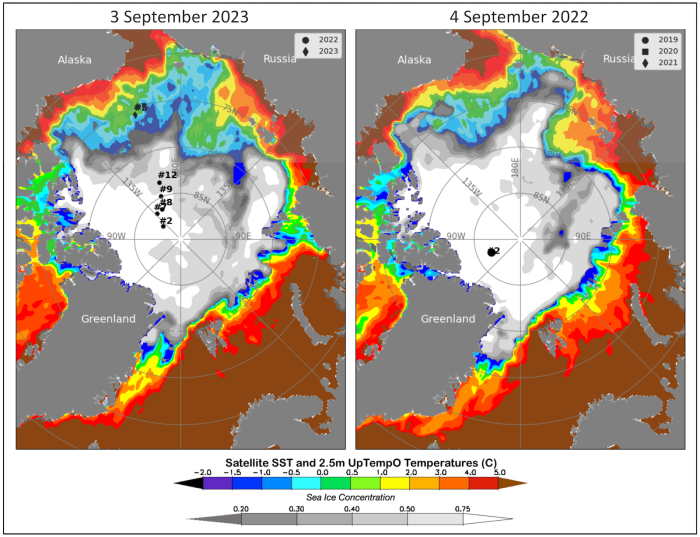
End-of-summer SSTs were quite warm and comparable in magnitude in the Eastern Beaufort, Northeastern Chukchi, and Laptev Seas in recent years (Figure 7). However, early fall freeze-up proceeds much more quickly in the Eastern Beaufort and Laptev Seas, relative to the Northeastern Chukchi (Figure 8). This is likely a result of warm water advection ("summer Pacific Water") from the south that feeds the Chukchi Sea, a Pacific analogue to the Atlantic Water warming discussed in the previous paragraph. This warm water advection delays fall freeze-up in the Chukchi, although eventually (i.e., in late fall / early winter) this area also freezes up.
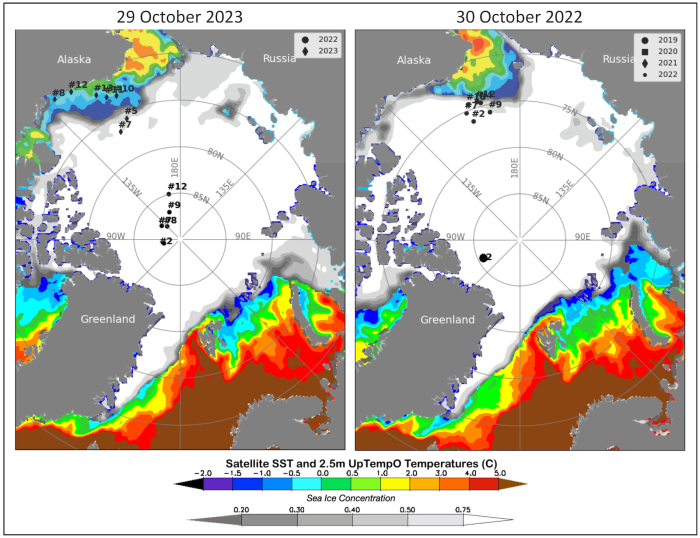
2023 SIO Forecasts
Pan-Arctic Forecasts and Pan-Arctic Sea-ice Extent Anomalies
The June, July, August, and September medians of the SIO contributions were 4.56, 4.66, 4.60, and 4.50 million square kilometers respectively (Figure 9). The monthly median Outlook values in 2023 increased from June to July, but then decreased each subsequent month, moving closer to the observed extent of 4.37 million square kilometers from the Sea Ice Index (thus, the error of the SIO median forecasts was 0.19, 0.29, 0.23 and 0.13 million square kilometers in the June, July, August and September SIO forecasts respectively). The contributions for all months bracketed that observed extent (black line in Figure 9), but the median forecast was higher than observed for all forecast months. The statistical methods also followed this pattern, while the dynamical model median remained fairly close to the observed value after June, but with a larger spread than the statistical methods.
The interquartile range (IQR) for the dynamical models (Figure 10) increased substantially from June to July, indicating substantial disagreement between models. However, the IQR then decreased in subsequent months. Statistical models showed a fairly consistent IQR over the season. The observed 2023 September mean sea ice extent was within the interquartile range (IQR) of the dynamical predictions in all months, but only in September for the statistical methods.
The pan-Arctic sea-ice extent anomaly is the departure of the contributors' September extent Outlook relative to the contributors' baseline trend. While this definition of the baseline trend adds uncertainty, it was chosen to let the broadest group of contributors participate in anomaly forecasts. A comparison of anomaly forecasts was motivated by the large spread in SIO contributions, which was hypothesized to be dominated by differences in model sea-ice extent biases; anomalies relative to the trend might reduce these biases. There were 15 (June), 15 (July), 13 (August), and 112 (September) contributions for anomaly forecasts for pan-Arctic sea-ice extent (Figure 11). The SIO anomaly forecast had median values of 0.27, 0.32, 0.17, and 0.11 million square kilometers in June, July, August, and September, respectively (Figure 12). In all months, the median forecasts exceed the observed September 2022 anomaly sea ice extent of -0.05 million square kilometers. Thus, the error of the SIO median anomaly forecasts was 0.32, 0.37, 0.22 and 0.1 million square kilometers in the June, July, August and September SIO forecasts respectively). Interestingly, these forecast errors are larger than the median forecast errors of absolute extent, noted above. The September SIO anomaly forecasts had standard deviations in million square kilometers of 0.26 in September, 0.31 in August, 0.50 in July and 0.34 in June. Only the September interquartile range contained the observed September mean sea-ice extent anomaly of -0.05 million square kilometers (Figure 12).
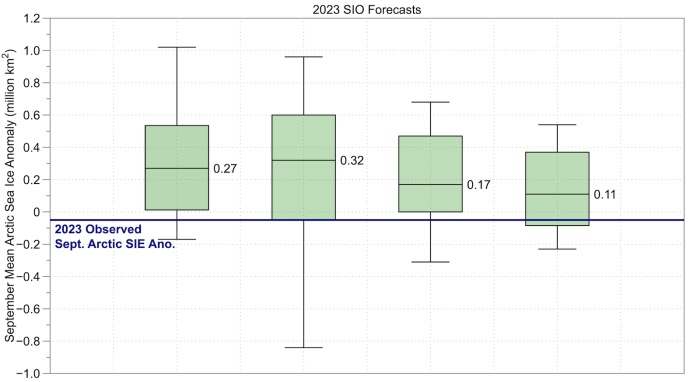
Alaska Seas
This year we again invited participants to submit forecasts of sea-ice extent for the Alaskan region, defined as the combination of the Bering, Chukchi, and Beaufort seas. We received a total of 38 forecasts over the four months: 10 in June, 9 in July, 10 in August, and 9 in September. Among these, 20 forecasts were based on statistical methods and 18 were based on dynamical models. For the Alaska region, the SIO median forecasts for June through September were 0.51, 0.55, 0.44, and 0.29 million square kilometers, respectively, which were all substantially greater than the observed sea-ice extent of 0.04 million square kilometers (Figure 13). The observed 2023 value is well outside the forecast interquartile range in all months as was the case in 2022 (Figure 14). Figure 15 places the 2023 SIO Alaska predictions in the context of past predictions from 2012—2022. The 2023 predictions edged closer to the observed value over the course of the summer season with the early September forecast being the best. Overall, the Alaska forecasts for 2021—2023 were not as accurate as those from 2017—2020.
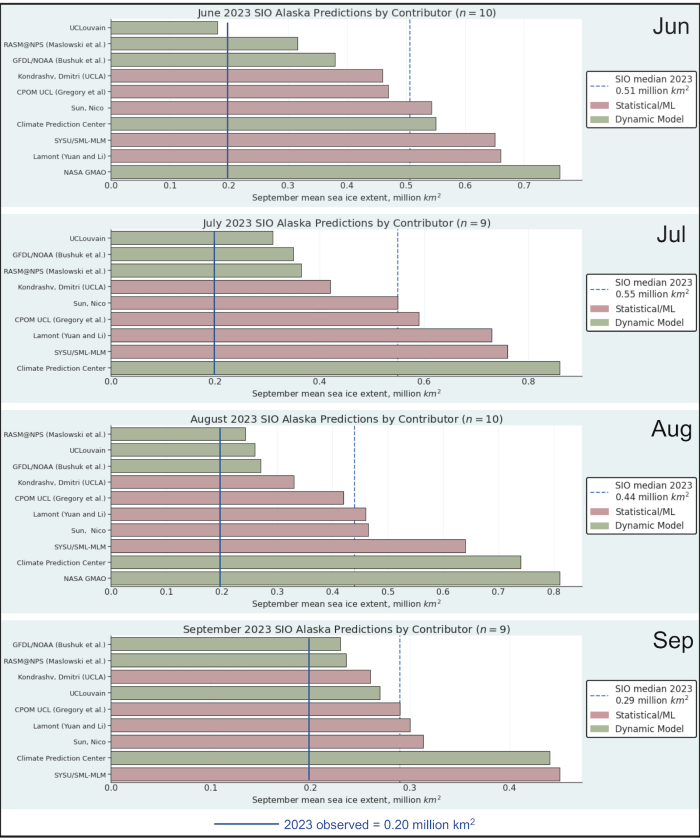
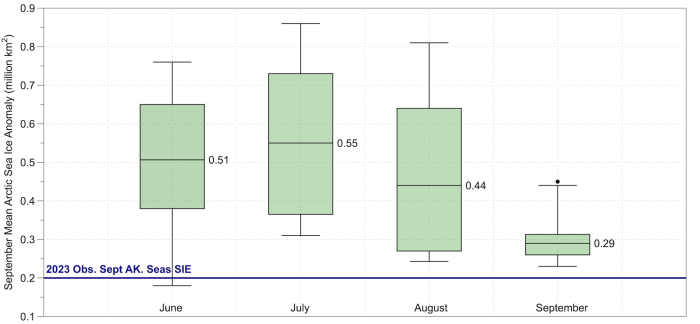
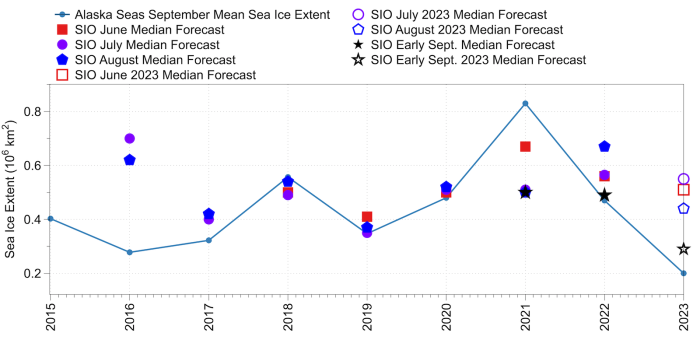
Pan-Arctic Spatial Forecasts
In the 2023 SIOs, we received 33 forecasts of Sea Ice Probability, or SIP (8 in June, 9 in July and August, 7 in September). The SIP is the spatial probability forecast of September concentration above 15%. We have calculated the forecasts' Spatial Probability Score (SPS, Goessling and Jung 2018), which is the area-integrated Brier Score (which itself is the mean squared error as applied to predicted probabilities, a value of zero representing perfect accuracy). Figure 16 shows the SPS for 2023 for all SIP forecasts, the SPS of the multi-model mean SIP forecast, and the SPS for a linear trend SIP forecast.
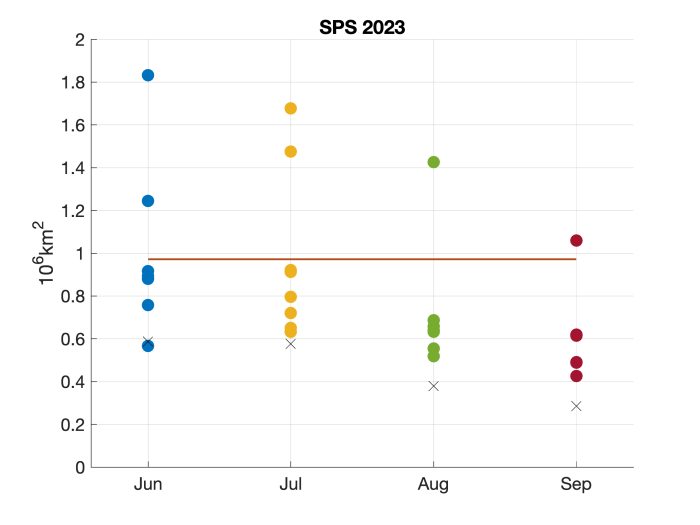
SPS values for individual models range from 0.5-1.8 million square kilometers in June forecasts to 0.4-1 million square kilometers in September forecasts. The SPS of the benchmark linear trend SIP forecast is almost 1 million square kilometers, and 17 out of 22 (over 75%) of individual forecasts in the June-August SIOs are more skilled than the benchmark SIP forecast. For all four SIO initializations, the multi-model forecast is more skilled than any of the individual forecasts, a feature observed in past years. This shows the value of having a multi-model forecast ensemble. The forecasts also show a consistent improvement from June to September initializations. In Figure 17 we show the August SIP forecasts, with the observed September sea-ice edge, in order to illustrate the skill of this year's forecasts. In Figure 18, we show the SPS of forecasts every year from 2014 to present, together with the percentage of individual June through August SIP forecasts that beat the benchmark linear trend forecast each year. In 2023 we saw the highest percentage value, supporting the long-term trend over the last decade of an improvement in SIP forecast skill.
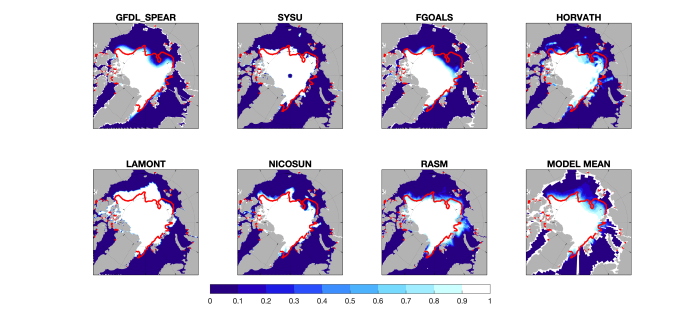
Antarctic Forecasts
According to the NSIDC Sea Ice Index, Antarctic sea-ice extent reached 16.80 million square kilometers on average for September 2023 (Figure 19), which was an extreme record low maximum extent in the satellite record, over 1 million square kilometers below the previous record low maximum. Below-average conditions have been predicted since June by the majority of the contributors, as well as by the benchmark persistence forecast. The results indicate clear added value over a climatological forecast, which confirms the findings for summer sea ice predictions (see the SIPN South project; Massonnet et al. 2023)
The reasons behind the exceptionally low Antarctic sea-ice conditions throughout 2023 remain to be elucidated. These conditions are in the wake of negative anomalies that have prevailed since 2016, and which might indicate a new state for Antarctic sea-ice (Purich and Doddridge, 2023).
Sea Ice Drift Forecast Experiment (SIDFEx)
In the framework of the Sea Ice Drift Forecast Experiment (SIDFEx), we have been collecting Lagrangian drift forecasts for the trajectories of Arctic and Antarctic buoys since 2017. Forecasts are submitted by 13 groups. In this contribution, we assess the forecast skill of three dynamical models (AWI Consortium, University of Washington/APL, and ECMWF SEAS5) that also contributed to the SIO 2023. All forecasts consist of several ensemble members (see legend of Figure 20 for the ensemble size).
We select a set of six buoys distributed relatively evenly over the regions which are still ice-covered by mid-September (Figure 20). For these buoys, we investigate forecasts initialized on the first of June, July, August and September, in line with the SIO submissions. We fit a 2D gaussian probability distribution to each forecast ensemble. The ellipses in Figure 20 display the 90% quantile of this distribution. This means that, if the ensemble is reliable, there should be a 90% chance that the position of the buoy is within the respective ellipse. We use this to define a hit rate as the metric for our assessment: the fraction of forecasts for which the buoy position lies within the 90% ellipse.
The hit rates range between 36% and 73% for five of the six buoys, which points to overconfidence, in line with what we found in earlier years. The fast drift of the sixth buoy from north of Greenland towards Fram Strait (Buoy 900128 [e] in Figure 20), however, was not captured by any of the forecast systems, resulting in a hit rate of 0%. The drift was already fast from July onward, when sea-level pressure was high over Greenland and the Canadian Archipelago and low towards Eurasia. It became even faster when the buoy left the pack ice and entered Fram Strait while low sea-level pressure prevailed around Svalbard in early September (see map in Figure 20). It is difficult to tell to what extent systematic forecast errors have a role to play here, or if the driving winds were simply too exceptional. The buoys with higher hit rates were all located in the Central Arctic or north of the Canadian Arctic Archipelago, where consolidated ice prevailed throughout.
It is worth noting that forecasts initialized on 1 September have consistently lower hit rates than forecasts initialized earlier. This might point to some initial adjustments or too slow error growth of wind forecasts on weather timescales. Such effects would diminish and lead to higher hit rates at longer lead times if ice drift on these longer time scales is dominated by mean climatology which the models can generally reproduce accurately.

Next Steps
This post-season SIO report marks the end of another boreal summer and the 2023 mean Arctic September sea-ice extent is now a part of our climate history. As we look ahead, the future of the SIO network is in flux as the SIPN2 project ended in 2022 and supplement funding was obtained for only 2023. We are currently seeking sources of support to continue the SIPN project and Outlooks into the future. We will of course share any news with the community as soon as we hear. We heartily thank the SIO community for their active and generous participation in this endeavor and without the community this network would not have been such a success. At the 2021 Contributors Forum, the community communicated that they wanted this network to continue and the SIPN team is doing its best to make that happen.
Seasonal forecasting is one of the most challenging problems that climate scientists face and it requires diverse skill sets that can be galvanized through a network to create new knowledge. We should also keep in mind that progress on seasonal forecasting is incremental and acknowledging this guides our expectations of success to be realistic.
The SIO network has matured to a level that it is ready for new challenges. One activity that has emerged is the apples-to-apples SIO forecast evaluation led by Mitch Bushuk of GFDL. This activity has submissions from 17 statistical models, 16 dynamical models, and 1 heuristic prediction. The predictions of September sea-ice extent (SIE) span the 2001—2020 period and will evaluate Pan-Arctic SIE, regional SIE, sea-ice concentration, initial conditions, and ensembles. The initial analysis has already revealed new insights and we look forward to finalizing and sharing the complete results. A manuscript on this analysis, led by Mitch Bushuk, has recently been submitted and is currently in review at the Bulletin of the American Meteorological Society (BAMS).
Another manuscript, led by Ed Blanchard-Wrigglesworth, that evaluates the skill of the SIO over 2008—2022, was published in early 2023 (Blanchard-Wrigglesworth et al., 2023). Finally, a third manuscript that describes the development of the SIO network and discusses the lessons learned that were only possible because of the network is under development. One example is the diffusion of ideas from economics that were used to create competitive SIO predictions (Diebold and Gobel 2022). SIO community members with an interest in contributing to the network story should contact Uma Bhatt (usbhatt [at] alaska.edu).
We thank the Sea Ice Outlook community for contributing to another season and look forward with hope for a continuation in the 2024 season and beyond.
References
Blanchard-Wrigglesworth, E., M. Bushuk, F. Massonnet, L.C. Hamilton, C.M. Bitz, W.N. Meier, and U.S. Bhatt (2023). Forecast skill of the Arctic Sea Ice Outlook 2008-2022. Geophys. Res. Lett., 50, e2022GL102531, https://doi.org/10.1029/2022GL102531.
Bushuk, M., and co-authors. Predicting September Arctic sea ice: A multi-model seasonal skill comparison, submitted to Bull. Am. Meteorol. Soc.
Comiso, J.C., W.N. Meier, and R. Gersten, 2017. Variability and trends in the Arctic sea ice cover: Results from different techniques. J. Geophys. Res., 122, 6883-6900, https://doi.org/10.1002/2017JC012768.
Diebold, F. X., & Rudebusch, G. D. (2022). Probability assessments of an ice-free Arctic: Comparing statistical and climate model projections. Journal of Econometrics, 231(2), 520-534.
DiGirolamo, N., C. L. Parkinson, D. J. Cavalieri, P. Gloersen, and H. J. Zwally. (2022). Sea Ice Concentrations from Nimbus-7 SMMR and DMSP SSM/I-SSMIS Passive Microwave Data, Version 2 [Data Set]. Boulder, Colorado USA. NASA National Snow and Ice Data Center Distributed Active Archive Center. https://doi.org/10.5067/MPYG15WAA4WX.
Fetterer, F., K. Knowles, W. N. Meier, M. Savoie, and A. K. Windnagel. (2017). Sea Ice Index, Version 3 [Data Set]. Boulder, Colorado USA. National Snow and Ice Data Center. https://doi.org/10.7265/N5K072F8.
Kalnay, E., et al. (1996) The NCEP/NCAR 40-Year Reanalysis Project. Bulletin of the American Meteorological Society,77,437-471. https://doi.org/10.1175/1520-0477(1996)077<0437:TNYRP >2.0.CO;2.
Lavergne, T., Sørensen, A. M., Kern, S., Tonboe, R., Notz, D., Aaboe, S., Bell, L., Dybkjær, G., Eastwood, S., Gabarro, C., Heygster, G., Killie, M. A., Brandt Kreiner, M., Lavelle, J., Saldo, R., Sandven, S., and Pedersen, L.T. (2019). Version 2 of the EUMETSAT OSI SAF and ESA CCI sea-ice concentration climate data records, The Cryosphere, 13, 49–78, https://doi.org/10.5194/tc-13-49-2019.
Massonnet, F., and others, 2023. SIPN South: six years of coordinated seasonal Antarctic sea ice predictions, Front. Mar. Sci., 10, https://doi.org/10.3389/fmars.2023.1148899.
Meier, W.N., and J.S. Stewart, 2019. Assessing uncertainties in sea ice extent climate indicators, Env. Res. Letters, 14, 035005, https://doi.org/10.1088/1748-9326/aaf52c.
Meier, W. N., J. S. Stewart, H. Wilcox, M. A. Hardman, and D. J. Scott. (2021). Near-Real-Time DMSP SSMIS Daily Polar Gridded Sea Ice Concentrations, Version 2 [Data Set]. Boulder, Colorado USA. NASA National Snow and Ice Data Center Distributed Active Archive Center. https://doi.org/10.5067/YTTHO2FJQ97K.
Purich, A., and E.W. Doddridge, 2023 Record low Antarctic sea ice coverage indicates a new sea ice state. Commun Earth Environ., 4, 314, https://doi.org/10.1038/s43247-023-00961-9.
Sledd, A., T.S. L'Ecuyer, J.E. Kay, and M. Steele, 2023. Clouds increasingly influence Arctic sea surface temperatures as CO2 rises, Geophys. Res. Lett., https://doi.org/10.1029/2023GL102850.
Tschudi, M., W. N. Meier, J. S. Stewart, C. Fowler, and J. Maslanik. (2019a). EASE-Grid Sea Ice Age, Version 4 [Data Set]. Boulder, Colorado USA. NASA National Snow and Ice Data Center Distributed Active Archive Center. https://doi.org/10.5067/UTAV7490FEPB.
Tschudi, M., W. N. Meier, and J. S. Stewart. (2019b). Quicklook Arctic Weekly EASE-Grid Sea Ice Age, Version 1 [Data Set]. Boulder, Colorado USA. NASA National Snow and Ice Data Center Distributed Active Archive Center. https://doi.org/10.5067/2XXGZY3DUGNQ.
Report Credits
This report was developed by members of the SIPN2 Leadership Team.
Report Lead:
Walt Meier, National Snow and Ice Data Center, CIRES, University of Colorado, Boulder
Additional Contributors:
Matthew Fisher and the NSIDC Development Team, Cooperative Institute for Research in Environmental Sciences at the University of Colorado Boulder, NSIDC
Helge Goessling, Alfred-Wegener Institute, Helmholtz Centre for Polar and Marine Research
Valentin Ludwig, Alfred-Wegener Institute, Helmholtz Centre for Polar and Marine Research
Editors:
Betsy Turner-Bogren, ARCUS
Helen Wiggins, ARCUS
Suggested Citation:
W. Meier, U.S. Bhatt, E. Blanchard-Wrigglesworth, F. Massonnet, H. Goessling, V. Ludwig, P. Bieniek, H. Eicken, M. Fisher, L. C. Hamilton, J. Little, J.E. Overland, M. Serreze, M. Steele, J. Stroeve, J. Walsh, M. Wang, and H. V. Wiggins. Editors: Turner-Bogren, B. and H. V. Wiggins. January 2024. "Sea Ice Outlook: 2023 Post Season Report." (Published online at: https://www.arcus.org/sipn/sea-ice-outlook/2023/postseason)
This Sea Ice Outlook Report is a product of the Sea Ice Prediction Network (SIPN), which was supported during 2023 in part by the National Science Foundation under Grant No. 1331083. Any opinions, findings, and conclusions or recommendations expressed in this material are those of the author(s) and do not necessarily reflect the views of the National Science Foundation.




